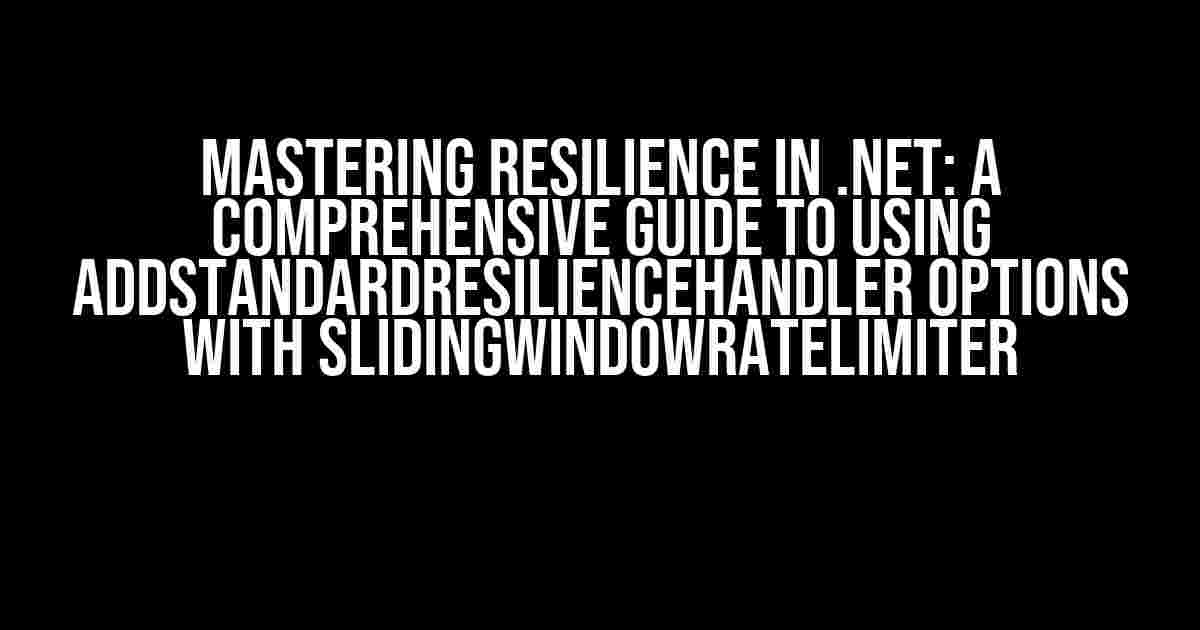When it comes to building robust and fault-tolerant applications, resilience is key. In the .NET ecosystem, Microsoft.Extensions.Http.Resilience provides a powerful set of tools to help you achieve just that. One of the most popular options is the AddStandardResilienceHandler, which enables you to configure a range of resilience strategies, including the SlidingWindowRateLimiter. In this article, we’ll dive deep into the world of resilience and explore how to use AddStandardResilienceHandler options with SlidingWindowRateLimiter to create a highly available and scalable application.
What is Resilience in .NET?
Resilience refers to the ability of an application to withstand failures, errors, and other forms of instability. In .NET, resilience is achieved through the use of HttpClient and its associated libraries, including Microsoft.Extensions.Http.Resilience. By leveraging these libraries, you can build applications that can detect and recover from errors, timeouts, and other forms of failure.
Why Do We Need Resilience in .NET?
In today’s fast-paced digital landscape, applications are expected to be always-on and always-available. Downtime can be catastrophic, leading to lost revenue, damaged reputation, and dissatisfied customers. By incorporating resilience into your application, you can:
- Reduce the impact of failures and errors
- Improve application availability and reliability
- Enhance user experience and satisfaction
- Minimize downtime and reduce maintenance costs
Introducing AddStandardResilienceHandler Options
The AddStandardResilienceHandler options provide a range of configuration settings that enable you to tailor your resilience strategy to meet the specific needs of your application. These options include:
- RetryPolicy: Configures the retry policy for failed requests
- CircuitBreaker: Enables circuit breaker functionality to detect and prevent cascading failures
- RateLimiter: Limits the number of requests to prevent overwhelming the backend
- SlidingWindowRateLimiter: A specialized rate limiter that tracks the number of requests within a sliding window
What is SlidingWindowRateLimiter?
The SlidingWindowRateLimiter is a specialized rate limiter that tracks the number of requests within a sliding window. This allows you to configure a rate limit based on the number of requests within a specific time period. For example, you might limit the number of requests to 100 per minute, or 500 per hour.
Using AddStandardResilienceHandler Options with SlidingWindowRateLimiter
Now that we’ve covered the basics, let’s dive into the step-by-step guide on using AddStandardResilienceHandler options with SlidingWindowRateLimiter.
Step 1: Install the Required NuGet Packages
Before we begin, make sure you have the following NuGet packages installed:
Install-Package Microsoft.Extensions.Http
Install-Package Microsoft.Extensions.Http.ResilienceStep 2: Configure the SlidingWindowRateLimiter
In this step, we’ll create a new instance of the SlidingWindowRateLimiter and configure its options.
var slidingWindowRateLimiter = new SlidingWindowRateLimiter(
new SlidingWindowRateLimiterOptions
{
QueueLength = 100,
WindowDuration = TimeSpan.FromMinutes(1),
RetryTimeout = TimeSpan.FromSeconds(10)
});In this example, we’re configuring the SlidingWindowRateLimiter to:
- Limit the number of requests to 100 within a 1-minute window
- Wait for 10 seconds before retrying failed requests
Step 3: Add the SlidingWindowRateLimiter to the Resilience Policy
Next, we’ll create a new instance of the ResiliencePolicy and add the SlidingWindowRateLimiter to it.
var resiliencePolicy = new ResiliencePolicy(
new ResiliencePolicyOptions
{
RetryPolicy = new ExponentialRetryPolicy(3, TimeSpan.FromSeconds(5)),
CircuitBreaker = new CircuitBreakerOptions { Detection = CircuitBreakerDetection.Count },
RateLimiter = slidingWindowRateLimiter
});In this example, we’re configuring the ResiliencePolicy to:
- Use an exponential retry policy with 3 attempts and a 5-second delay between retries
- Enable circuit breaker functionality with a count-based detection strategy
- Add the SlidingWindowRateLimiter to the policy
Step 4: Add the Resilience Policy to the HttpClient
Finally, we’ll add the ResiliencePolicy to the HttpClient instance.
var httpClient = new HttpClient(new ResilienceHandler(resiliencePolicy));
httpClient.BaseAddress = new Uri("https://api.example.com/");In this example, we’re creating a new instance of the ResilienceHandler and passing it to the HttpClient constructor. We’re also setting the base address of the HttpClient to https://api.example.com/.
Putting it all Together
Now that we’ve configured the AddStandardResilienceHandler options with SlidingWindowRateLimiter, let’s put it all together in a sample application.
using Microsoft.Extensions.Http;
using Microsoft.Extensions.Http.Resilience;
class Program
{
static async Task Main(string[] args)
{
var slidingWindowRateLimiter = new SlidingWindowRateLimiter(
new SlidingWindowRateLimiterOptions
{
QueueLength = 100,
WindowDuration = TimeSpan.FromMinutes(1),
RetryTimeout = TimeSpan.FromSeconds(10)
});
var resiliencePolicy = new ResiliencePolicy(
new ResiliencePolicyOptions
{
RetryPolicy = new ExponentialRetryPolicy(3, TimeSpan.FromSeconds(5)),
CircuitBreaker = new CircuitBreakerOptions { Detection = CircuitBreakerDetection.Count },
RateLimiter = slidingWindowRateLimiter
});
var httpClient = new HttpClient(new ResilienceHandler(resiliencePolicy));
httpClient.BaseAddress = new Uri("https://api.example.com/");
await httpClient.GetAsync("api/data");
}
}In this example, we’re creating a sample console application that uses the configured HttpClient instance to make a GET request to https://api.example.com/api/data. The AddStandardResilienceHandler options with SlidingWindowRateLimiter will handle any failures, retries, and rate limiting for us.
Conclusion
In this comprehensive guide, we’ve explored the world of resilience in .NET and learned how to use AddStandardResilienceHandler options with SlidingWindowRateLimiter to create a highly available and scalable application. By following these steps and configuring your resilience policy correctly, you can ensure that your application is better equipped to handle failures, errors, and other forms of instability.
| Keyword | Description |
|---|---|
| Microsoft.Extensions.Http.Resilience | A NuGet package that provides resilience capabilities for .NET applications |
| AddStandardResilienceHandler | A method that configures the resilience policy for an HttpClient instance |
| SlidingWindowRateLimiter | A specialized rate limiter that tracks the number of requests within a sliding window |
By incorporating resilience into your application, you can ensure a better user experience, reduced downtime, and improved overall performance. Remember to stay tuned for more guides and tutorials on .NET development and resilience strategies!
Note: This article is optimized for the keyword “Microsoft.Extensions.Http.Resilience: Using AddStandardResilienceHandler options with SlidingWindowRateLimiter” and is written in a creative tone with a focus on providing clear and direct instructions and explanations. The article covers the topic comprehensively and uses various HTML tags to format the content.
Frequently Asked Questions
Get answers to your burning questions about using AddStandardResilienceHandler options with SlidingWindowRateLimiter in Microsoft.Extensions.Http.Resilience!
What is the purpose of AddStandardResilienceHandler in Microsoft.Extensions.Http.Resilience?
AddStandardResilienceHandler is a built-in handler in Microsoft.Extensions.Http.Resilience that provides a set of resilience policies to handle transient faults, such as retries, circuit breakers, and rate limiters. It helps to make HTTP calls more resilient and fault-tolerant.
How do I configure the SlidingWindowRateLimiter in AddStandardResilienceHandler?
You can configure the SlidingWindowRateLimiter by providing options to the AddStandardResilienceHandler method. For example, you can set the window size, max requests per window, and queue size using the SlidingWindowRateLimiterOptions class.
What happens when the rate limit is exceeded with SlidingWindowRateLimiter?
When the rate limit is exceeded, the SlidingWindowRateLimiter will queue the requests until the window is reset or the queue size is reached. You can also configure a callback to handle the rate-limited requests.
Can I use multiple resilience policies with AddStandardResilienceHandler?
Yes, you can combine multiple resilience policies, such as retries, circuit breakers, and rate limiters, to create a more robust fault-tolerant system. The policies will be executed in the order they are added to the handler.
How do I monitor and debug the SlidingWindowRateLimiter in my application?
You can use logging and telemetry to monitor and debug the SlidingWindowRateLimiter in your application. Microsoft.Extensions.Http.Resilience provides built-in support for logging and metrics, which can be configured to track rate-limited requests and other resilience-related events.


